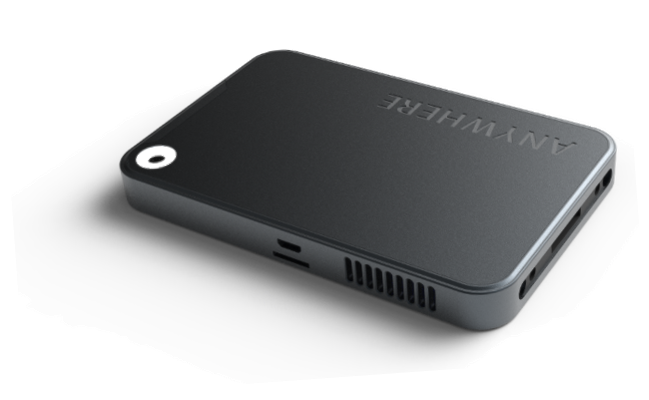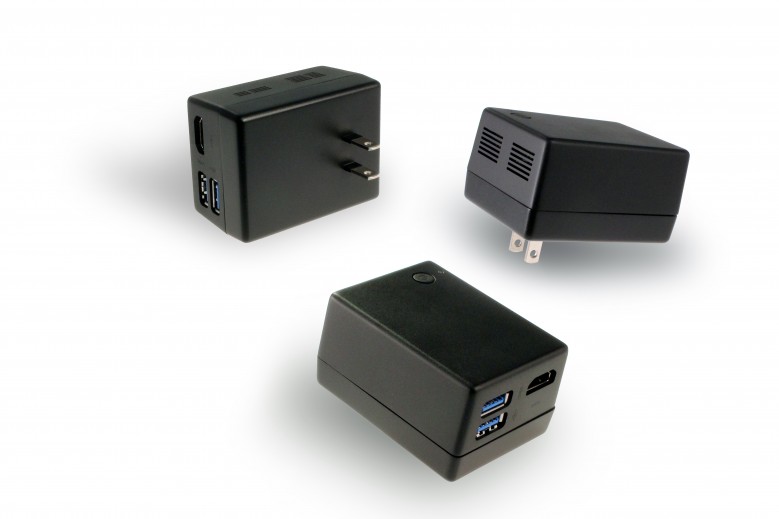Microsoft Reveals New Computer Form Factors Coming With Windows 10
FoxConn and Quanta are both working on new, compact computing form factors to get Windows 10 devices into the living room, presumably for low prices.
In January of this year, Intel announced the Compute Stick (see our review here), a small computing device that can plug directly into a TV to bring PC functionality to the living room at a very low price point. The device runs a version of Windows and allows users to do rudimentary tasks, like web browsing, chatting on Skype or watching streaming content.
Fast forward to today and we've got a few competitors on the horizon. At Computex 2015 during the Microsoft keynote on Windows 10 and what the future holds for the new OS, several products were shown, including two that are exploring brand new form factors.
FoxConn has a new product called Kangaroo in the works. Billed as an ultra-portable desktop, it features one of Intel's latest Cherry Trail processors (the same one found in 7- to 10-inch tablets), and runs off of internal battery power. From the above image, the Kangaroo looks to be a similar size to a typical portable battery for smartphones. The battery life is said to offer six hours on a single charge.
Perhaps the most interesting feature about FoxConn's Kangaroo is the inclusion of a fingerprint scanner to support Windows Hello, Microsoft's biometric sign-in system for the newest version of Windows. With this feature, signing in with a username and password is no longer necessary.
Quanta also showcased a new form factor at Computex. The Compute Plug takes the idea of a portable desktop in a slightly different direction. While Intel's Compute Plug uses the TV as a power source, and FoxConn relies on a battery to power the Kangaroo, the Compute Plug is built right into a power adapter. It closely resembles a power adapter for something like a router or switch, except without any hardwired cables. Instead, there are two USB ports (no word yet if they are 3.0 or 3.1) and an HDMI port to plug into a display.
The Compute Plug uses Bluetooth to connect to a remote or headset, and Cortana is used to control the system. It's unclear if USB input will work or not, though with USB ports shown in the image above it's hard to believe that it wouldn't.
There was no indication as to when these two unique computing devices will be made available, and pricing has not been revealed at this time.
Get Tom's Hardware's best news and in-depth reviews, straight to your inbox.
Follow us @tomshardware, on Facebook and on Google+.
Kevin Carbotte is a contributing writer for Tom's Hardware who primarily covers VR and AR hardware. He has been writing for us for more than four years.
-
PaulBags I like the ideas. But I don't want a battery powered pc, and wall warts are just too annoying to fit around other plugs and even some plugs switches.Reply
A either with a figure 8 connector would be fine, but then they wouldn't be 'innovative'. -
wirefire99 I cannot comment on the "official" word from Intel / Microsoft. but I have build 10122 x32 working on my intel compute stick without issue. (yes I found drivers to run the atom chipset, HD display, etc that Intel does not offer on its website.)Reply -
rluker5 Neat. I still like the 8" Toshiba Encore I have HDMI plugged into my TV right now better though. I can unplug it and then I have a tablet. But Cherry Trail will be an improvement.Reply -
alextheblue ReplyI like the ideas. But I don't want a battery powered pc, and wall warts are just too annoying to fit around other plugs and even some plugs switches.
I've never had a problem plugging wall warts into a decently designed power strip. Heck when I hook up my Model 2 Genesis/Sega CD/32X combo I need three large wall warts just for the computing hardware. But for those who struggle with plugging things in (TV infomercial style with wires all wrapped around their neck and ankles while they try to plug something in), you can get a 1 foot extension cable for like a dollar. This would be a convenient cheap streaming unit for on the go and it could double as a USB charging wart. :P
Neat. I still like the 8" Toshiba Encore I have HDMI plugged into my TV right now better though. I can unplug it and then I have a tablet. But Cherry Trail will be an improvement.
Well I don't think this is exactly intended to take tablets head on. It's meant to compete with various TV-connected units. However it is more flexible than any of those... so it may have a place. The battery also makes it appealing to me because if it's in the middle of doing something important, it doesn't lose data if you lose power. But yeah, there's lots of fair-enough cheap x86 tablets now... but a good Cherry Trail X7 unit (ala Surface 3) of decent size, clock, and quality will set you back a decent chunk. -
epobirs ReplyI like the ideas. But I don't want a battery powered pc, and wall warts are just too annoying to fit around other plugs and even some plugs switches.
I've never had a problem plugging wall warts into a decently designed power strip. Heck when I hook up my Model 2 Genesis/Sega CD/32X combo I need three large wall warts just for the computing hardware. But for those who struggle with plugging things in (TV infomercial style with wires all wrapped around their neck and ankles while they try to plug something in), you can get a 1 foot extension cable for like a dollar. This would be a convenient cheap streaming unit for on the go and it could double as a USB charging wart. :P
Neat. I still like the 8" Toshiba Encore I have HDMI plugged into my TV right now better though. I can unplug it and then I have a tablet. But Cherry Trail will be an improvement.
Well I don't think this is exactly intended to take tablets head on. It's meant to compete with various TV-connected units. However it is more flexible than any of those... so it may have a place. The battery also makes it appealing to me because if it's in the middle of doing something important, it doesn't lose data if you lose power. But yeah, there's lots of fair-enough cheap x86 tablets now... but a good Cherry Trail X7 unit (ala Surface 3) of decent size, clock, and quality will set you back a decent chunk.
Sega actually made a power strip just for the Genesis/CD/32X. Instead of six plugs as typical, it had five plugs with spaces containing blue letters spelling S E G A. When Good Guys, a SoCal consumer electronics chain, was going under, they blew these out for $2 each. I bought a bunch and still have some in use today. -
Camikazi ReplyUseless after another useless release from Microsoft.
Useless to you but I like the looks of that wall plug computer, I want a few of those for my TVs and turn them into HTPCs. Them running full Windows just makes them even better since with it you can run anything you want easily and they should be low power usage. Don't assume the world sees everything the same way you do, thinking something is useless does not make it useless, it mostly just makes you unimaginative. -
grumpigeek Microsoft say they want to get Windows 10 devices into the living room yet they removed the most useful living room application of all - Windows Media Center.Reply
Windows Media Center (WMC) just worked with no hassles.
I have been trying potential replacements (like Kodi, Media Portal, NextPVR) for WMC but none of them work properly. In fact, I am struggling to get any of them to work at all.
So Windows 10 has zero chance in my living room.

